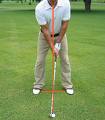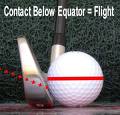How to Hit Long Irons in Golf

One of the most difficult things for many beginning golfers to do is to learn how to hit their long irons correctly. Before we get into specifics, let’s discuss a few things specific to long irons and how they relate to the game of golf today.
What are the long irons?
Long irons are the golf clubs from the 1-iron to the 5-iron. These clubs have relatively long shafts with the 1-iron having the longest shaft with the club shafts getting progressively shorter as we go down in clubs from the one through the five iron.
Do golfers even use these long irons anymore?
While it is true that some of the newer fairway woods have replaced some of the longest irons (e.g. 1, 2, and 3-iron) for many golfers, there certainly is a time and place for the long irons. Many of you have probably heard of Tiger Woods hitting his ‘stinger 2-iron’ when he is looking for a specific alternative to his Driver.
Discover the Best Swing to use with your Long Irons!
Additionally, one of the most famous golf shots was executed by Jack Nicklaus using a 1-iron at the 1972 US Open. Today many golfers – especially beginners – no longer carry a 1-iron or a 2-iron, opting for fairway woods to cover similar distances, instead. But many golfers still carry the 3-iron, 4-iron, and of course 5-iron. Learning how to hit the long irons is essential to the development of any novice golfer who wants to improve his or her game and developing a simple golf swing can be most effective when used in conjunction with these clubs.
Why are the long irons so difficult to hit?
I think there are a few reasons why beginners have difficulty hitting the long irons. First off, the longer the shaft of any golf club, the more difficult it is to hit. The reason is because golf clubs with longer shafts force the golfer to stand farther away from the ball. Standing farther away from your target (i.e. the ball) makes it more difficult to hit the target/ball correctly. Also, the lower the number of the club – the longer the iron – the less angle the club head has to it. I believe that there is a psychological factor or hurdle that beginners must overcome – even with today’s most forgiving irons – and that is believing that a club with such a minute angle will actually produce a solid golf shot. The game of golf has two components – one mental and one physical. In the rest of this article, I am going to help you understand what you need to be doing physically in order to hit a proper golf shot with your long irons. Learn how to overcome some of the mental hurdles any new golfer faces,
How to Hit Long Irons – The Proper Stance
 There is too much made of exactly how far away from the golf ball to stand or where to position the ball between your front and back foot when setting up for you swing. Let’s just take it one step at a time. Long irons have longer shafts and the length of the shaft dictates how far away from the ball you stand and where to place the ball between your from and back feet. When hitting a long iron, make sure that you are comfortable and that the club head will not hit the ground before hitting the ball.
There is too much made of exactly how far away from the golf ball to stand or where to position the ball between your front and back foot when setting up for you swing. Let’s just take it one step at a time. Long irons have longer shafts and the length of the shaft dictates how far away from the ball you stand and where to place the ball between your from and back feet. When hitting a long iron, make sure that you are comfortable and that the club head will not hit the ground before hitting the ball.
The diagram above depicts a proper golf stance for addressing the ball when using one of the long irons. In it, you will see that the ball is positioned in the middle of the golfers feet and that he is standing far enough from the ball to accommodate the longer shaft length of this club. Many golfers feel more comfortable with the ball slightly forward in their stance when using a long iron and that’s OK too. One thing you should avid though with these clubs is having the ball too far back in your stance.
How to Hit Long Irons – The Proper Grip
 The standard interlocking golf grip is perfectly suitable for hitting long iron golf shots. In this grip, the index finger of the left hand and the pinky of the right hand will be interlocked (for right-handed golfers) producing a grip in which the right hand is in front of the left or lower on the club at address.
The standard interlocking golf grip is perfectly suitable for hitting long iron golf shots. In this grip, the index finger of the left hand and the pinky of the right hand will be interlocked (for right-handed golfers) producing a grip in which the right hand is in front of the left or lower on the club at address.
How to Hit Long Irons – The Proper Swing
Click Here to See What Swing Most Golfers Use With The Long Irons!
Beginning golfers should strive to perfect a comfortable swing that they can execute repeatedly no matter what club they happen to be using. The best swing to use when hitting a long iron is any swing that you feel comfortable with. Properly positioning the ball between your feet and standing an appropriate distance from the ball should put you in good position to execute the swing.
How to Hit Long Irons – Club Face at Impact
 This is one of the keys to good long iron play and probably one of the areas that gives beginners the most difficulty. Once you have followed the tips above and have a good set-up for your long iron shot the next thing to do is make sure that the result of your swing produced a club face that is square at impact and make sure that the face contacts the ball before the ground. Refer to the picture to the left. Strive to aim the leading or bottom edge of your long iron somewhere just below the mid-point or ‘equator’ of the golf ball.
This is one of the keys to good long iron play and probably one of the areas that gives beginners the most difficulty. Once you have followed the tips above and have a good set-up for your long iron shot the next thing to do is make sure that the result of your swing produced a club face that is square at impact and make sure that the face contacts the ball before the ground. Refer to the picture to the left. Strive to aim the leading or bottom edge of your long iron somewhere just below the mid-point or ‘equator’ of the golf ball.
Try to have the bottom edge of your long iron contact the ball just prior to contacting the ground below the equator and the result will be a good flight path for the ball with proper loft. As in the diagram above, make sure that the club face impacts the ball squarely.
The Follow-Through
Maintain consistent momentum when hitting the ball and make sure to follow-through and complete your swing. As you come through the golf ball make certain that you achieve full rotation with your hips and the result will be one of the best long-iron shots you’ve ever hit.
Check Out More Free Long Iron Tips To Improve Your Game
Conclusion
So learning how to hit long irons in golf is not really all that difficult it’s just another aspect of the game that can be so frustrating and so addictive at the same time. As with anything practice makes perfect so get out to the range and practice your long iron shots using some of the tips above and soon you’ll be opting for your 3,4, or 5-iron before grabbing that fairway wood next time you’re out on the course.

One Comment